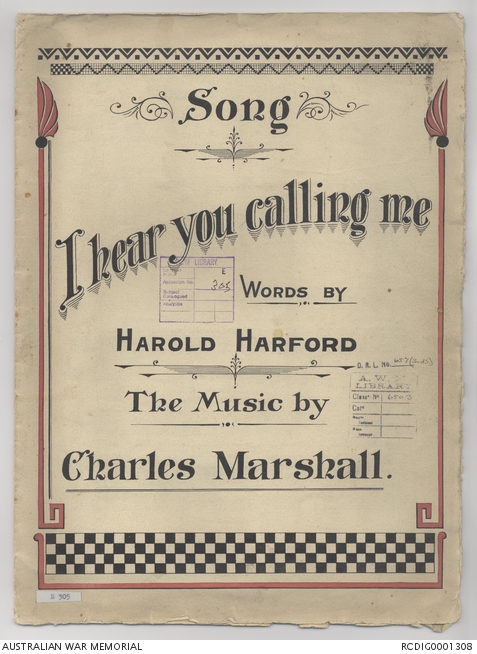Sing us a song...
The Australian War Memorial holds a growing collection of sheet music which currently includes over 900 titles. The collection includes both individual pieces, and compilations of sheet music. The date range of this collection extends from the 1850s through to the mid-2000s. Of these approximately 250 pieces relate to the First World War.
Some of the music held in the Memorial’s collection was written by service people themselves, either during the war or after return to Australia, or by iconic and well-known composers and lyricists. A number of the songs were performed by concert parties, or were heard at concerts in London or Paris.
The Memorial’s Published Collections team has recently begun a project to digitise the Memorial’s collection of sheet music from the First World War. This project began with the digitisation of five pieces of music performed at the Memorial’s Friends’ Gala Dinner on 3 October 2014. These pieces were selected for the stories told either through the lyrics, performances of the songs or previous owners of the music. The five pieces of sheet music can be found here.
One interesting song in the Published Collections is I hear you calling me. This song was first published in 1908, with the words written by journalist Harold Lake, under the pen name Harold Harford, some time after music was written by composer Charles Marshall. The work was published in multiple keys, and had been popularised through a recording by the Irish tenor John McCormack.
The Memorial’s copy of I hear you calling me, is written in C Major, and upon first glance it is undistinguishable from a commercially printed piece of the sheet music. However, this piece is a hand drawn, copied note for note by Gunner John Aitken Ballantyne, at the request of Sergeant Frederick Reginald Hedges. Both Hedges and Ballantyne worked in the Australian theatre industry prior to enlisting the Australian Imperial Force. In November 1917, Hedges and Ballantyne were both stationed at AIF Headquarters, Tidworth. Upon donating the piece to the Memorial, Hedges wrote,
I have a song copied at AIF Hdqrs, Tidworth, Salisbury Plains England in 1917, Cpl J Ballantyne who copied the song for me as a gift did not know a note of music and so it was copied note for note, the music lines of the stave being done by hand also on a parchment paper, it is a work of art, the front and back covers being splendidly worked, the music itself cannot be distinguished from a printed copy…
After the war, Hedges and Ballantyne both worked for the renowned theatre company J. C. Williamson Ltd. for many years. Hedges worked as a musician, and Ballantyne worked as a sign writer and mechanic.
Another interesting song is Sing us a song of Australia, with music and lyrics by Charles Ridgway (stage name Charlie Vaude). This song was popularised on the Tivoli Circuit by Miss Violet Trevenyon. Ridgway wrote the song after a lack of Australian songs at a benefit concert for Australian wounded, at His Majesty’s Theatre, London, on 19 November 1915. The cover of the song notes that “…the public hardly joined in a chorus. The Australians, who had no songs of their own on the programme, at the finish of Ada Crossley’s item, called ‘Coo-ee, Coo-ee,’ to each other across the Auditorium.” This refers to the Edward Sass poem Coo-ee, which Australian contralto Ada Crossley recited as an encore at the benefit concert.
The Memorial’s sheet music collection can be accessed through the Memorial’s collection search and more titles will be progressively released to the website following digitisation.

